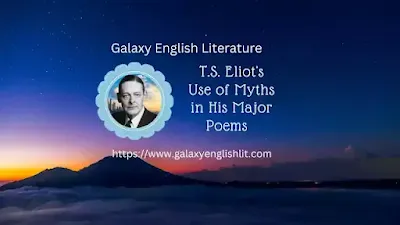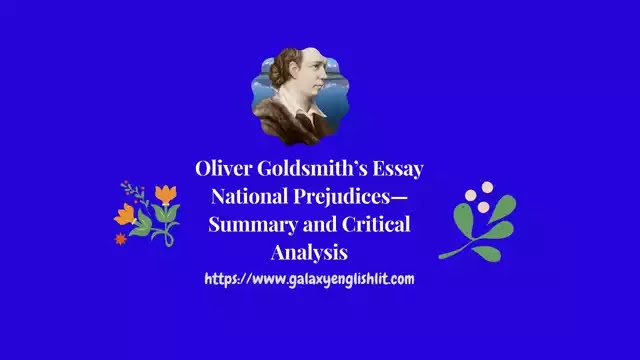The Use of Myths in Eliot's Poetry:
Eliot believed that modern poetry should be complex, allusive and even symbolist. Eliot has employed myths and symbolism in his major poems. The Waste Land is one of them. The central figure in the poem The Waste Land is Tiresias. He is a person of ancient Greek mythology. The title of the poem has derived from the Grail legend which also supplies the poem with its underlying theme of the barren land. Then Eliot connects his fertility concept with the myth of three Phoenician Greek gods - Adonis, Attis, and Osiris. The Phoenicians sacrificed Adonis and Osiris in spring - time, by drowning them. It was a ritual sacrifice and after it there was morning. In The Hollow Men, Eliot employs the myth of the Lethe River which flows between the land of life and the land of death, according to Roman Catholics. The ferryman of the river is said to be Charon. He takes the souls of the dead across the Lethe, to Heaven or Hell, as their deed demand. Eliot borrows this myth from Dante and then places hollow men on the bank of the Lethe.
 |
| T.S. Eliot's Use of Myths in His Major Poems |
The Employment of Pagan and Christian Myths:
Eliot has used both pagan and Christian myths. From Egypt, he borrowed of the fertility ritual myth. The effigy of the god of vegetation stocked with grains of corn on his body was buried under ground. After some days the grains sprouted. It was said that God was re - born. Sometimes the fertility god was drowned in the sea and after - while, when it floated it was said that god was reborn. The Christian myth is about the sinfulness of man and sufferings of Christ in atonement of man's sin and resurrection. The resurrection of Christ is a symbol of man's survival and prosperity.
Resemblance between the Vegetation and Fertility Myths:
There is a basic - resemblance between the vegetation myths of the rebirth of the year , the fertility myths of the rebirth of the potency of man, Christian story of the Resurrection , and the Grail legend purification. Through the device of contrast, Eliot highlights the squalor and ugliness of the present in relation to the past. The events of the past are brought in close juxtaposition with the events of the present. For example, the love of Queen Elizabeth and Earl of Leicester is not different from the sexual affair between the typist girl and a male clerk. Eliot's London is not different from Baudelaire's Paris and Dante's Limbo. The same ills and corruption prevail in the regions.
Employment of the Myths as a Literary Artist:
Eliot employs myths as a literary artist, and in the impressionistic style. For instance in the poem The Waste Land his use of myths suggests the nature of his theme and also its remedy, namely: the modern west is the waste land whose fertility can be reclaimed only by means of sacrifice. Eliot's remedy of ritual sacrifice suggests that the modern materialistic man has become mammonish and is devoted to money - making. His mammonism is the cause of his selfishness, lust and misery. Evidently, the first purpose behind Eliot's use of myths is suggestion of his themes. In his poem The Hollow Men, the myth of Lethe, Charon, Heaven, Hell, etc., suggests that modern world should give up materialism, accept Christian existentialism, and man should create spiritual values for himself.
The Employment of the Myths in the Concern of the Modern Problems:
Eliot uses myths in relation to the problems of the modern age. He uses myths in order to represent the concept of continuous time in relation to the human mind. By using his historical sense, Eliot has shown that the problems of the present day are not many. Such problems were faced by man in the past. They found out certain solutions which could be tried out. If we profit by the experience and wisdom of the past, we may be able to survive. The past shows that there have been periods of spiritual decay. A kingdom has been laid waste either by the sins of the ruler or by the havoc caused by the war. The land has been restored to prosperity and health by the sufferings and penance of rulers.
Providing Mythical Framework to the Poem:
Next Eliot uses myths in order to provide his poem with a mythical framework in which the past and the present stand side by side. The atmosphere is strange, and is a fusion of the ancient and the modern, of the timeless and the temporal. In the poem The Waste Land, ancient long - lived Tiresias visits the modern waste land. In The Burial of the Dead, he first listens to a conversation in a Munich cafe. The speaker is a girl called Marie. She is German, and describes how she spent the winter and welcomed the spring. Tiresias then makes a comment on materialism in relation to the modern man.
The Use of Myths for Enhancing Aesthetic Beauty:
Eliot uses myths for adding aesthetic beauty to his poetry. He believes that rich poetry is complex and the elements of its complex poetic thought are elements of various cultures. Maxwell observes: “Eliot has based his incidental symbolism on myths and legends. The basic symbolism is taken from the Grail legend, and particularly in the last section, Eliot introduces the journey symbol, which is well defined feature of European legend."





